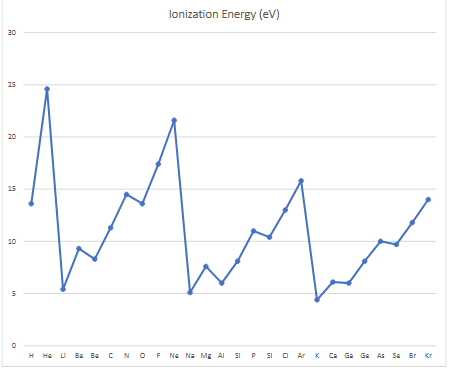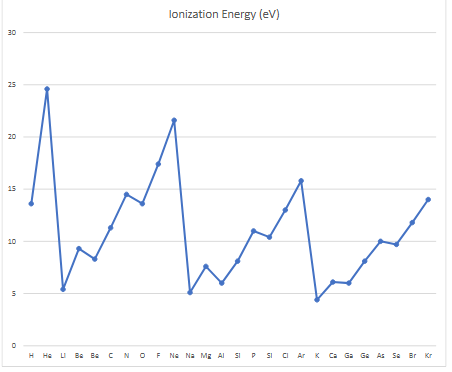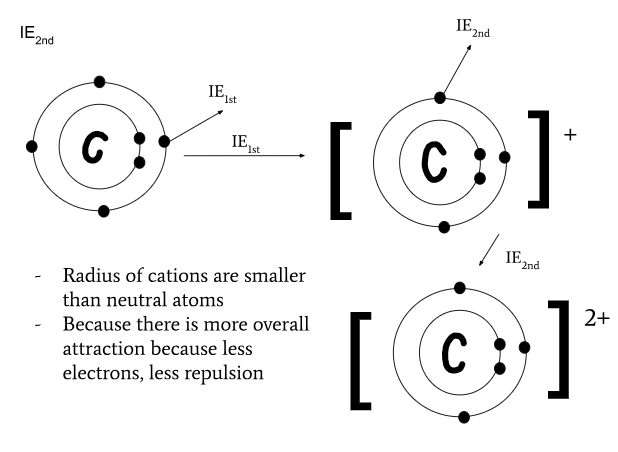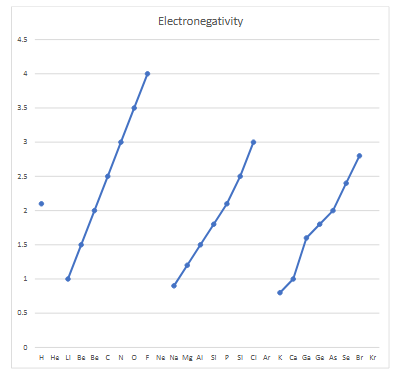periodic trends
1/21
Earn XP
Description and Tags
atomic radius 19-21/2/25, ionization energy 21-25/2/25, electron affinity and electronegativity 26/2/25, Zeff
Name | Mastery | Learn | Test | Matching | Spaced |
|---|
No study sessions yet.
22 Terms
atomic radius
Distance from the nucleus out to the valence shell
dependent and independent variable in AR graph
Atomic # = independent variable
Atomic radius = dependent variable

nuclear charge (Z)
positive charge present in the nucleus of an atom
keeps electrons in place
shielding
the repulsion of outer electrons by inner electrons
stronger than sideways repulsion
effective nuclear charge
Net attraction of electrons to the nucleus
Zeff = Z (nuclear charge) - shielding
sideways repulsion
repulsion between electrons on the same shell
causes spaces between electrons
weaker than shielding
mr.moniz term
trend of Zeff
across a period (left to right): protons increase while inner shielding electrons always stay the same, so effective nuclear charge also increases
down a group: a new shell is added, all inner orbits become shielding electrons, increased shielding and low inner p+:e- causes more repulsion than attraction, so effective nuclear charge decreases
trend of atomic radius
across a period (left to right): protons increasing, inner shielding electrons stay the same, so Zeff increases, causes increased attraction, electrons pulled in more closely, atomic radius decreases
down a group: AR does not increase because of an added orbit. A new valence orbit is added, inner orbits become shielding electrons, more repulsion, the p+:inner e- ratio decreases, valence is less drawn to the nucleus, atomic radius increases
ionization energy
minimum amount of energy required to remove an electron from a neutral element in the gaseous state producing a +1 cation
since minimum, it removes electron from valence shell
Xg + IE = Xg+ + e- (free electron)

trend of ionization energy
across periods (left to right): Zeff increases, shielding stays the same while p+ increases, causing more attraction, more energy needed to remove e-, p+:inner e= ratio increasing, ionization energy increases
down a group: Zeff decreases, new shielding orbit, more repulsion than attraction, less energy required dislodge e-, p+:inner e- ratio decreases, ionization energy decreases

what does the spike in the ionization energy graph show?
jumps to inner orbit
inner electron is removed
requires proportionally much more energy to remove the inner electrons because the effective nuclear charge has drastically increased

multiple ionization energies
minimum energy required to remove subsequent electron to form a cation in an element in its gaseous state
Xg+ + IE2nd = Xg2+ + e- (+2 cation and free electron)
change is discontinuous
each subsequent electron needs more energy to be removed
why is more IE needed overtimr?
Sideways repulsion is decreased because the first electron was removed from valence shell
nuclear charge is more effective because the sideways repulsion decreases
overall repulsion decreases so the attraction is more effective
attraction itself does not increase but bc repulsion is less, overall attraction increases
electron affinity
energy released by a neutral atom in the gaseous state when it attracts an electron to form a -1 anion (negative energy)
X(g) + e- → X-(g) + E.A
why is energy releases when an electron is added to a neutral atom
the electron is attracted to the positively charged nucleus
meteor analogy: attracted to earth, pulled by gravity, accerlates towards earth, potential energy is being converted to kinetic energy, energy converted to heat and sound
electron attracted to nucleus, falling into atom and losing potential energy
energy released as light once electron reaches atom, this energy is EA
what does it mean if an electron needs to be pushed into an atom (IE)?
that means there is repulsion (from the other electrons there)
repulsion to add electron: negative electron affinity written as a positive number
electronegativity
a calculated average of measurements indicating the tendency of an element to attract an electron charge towards it in a compound

What factors allow metallic elements to form ions where they have lost their valence electrons?
Metallic elements effective nuclear charge is low
IE is also low
The proton to inner electron ratio is lower
so metallic elements are more likely to form cations because they have lower ionization energy
stable
how difficult is something to change, is it difficult or easy to change
electron affinity
energy released by a neutral atom in the gaseous state when it attracts an electron to form a -1 anion, exothermic
electronegativity and electron affinity trend
across a period (left to right): both increase, EN: more protons, unchanged shielding, Zeff increases, more attraction, greater tendency to attract electron. EA: more energy given off when anion forms
down a group: both decrease, EN: new shielding, more repulsion than attraction, tendency to gain electron is less. EA: greater repulsion, less energy released when anion is formed
noble gasses do not attract electrons because the valence shell is full, and much more energy is needed to overcome the repulsion for an electron to go into the next shell
noble gasses have high IE and are less likely to lose an electron
all trends general
left to right: Zeff increases, AR decreases, IE increases, EN and EA increases
down a group: Zeff decreases, AR increases, IE decreases, EN and EA decreases